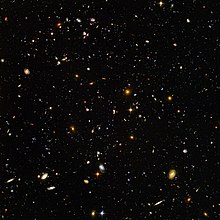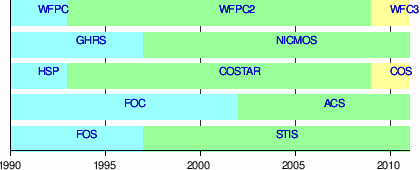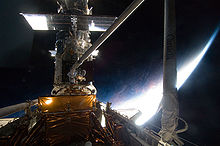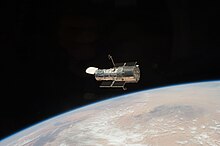Scientific results
Key Projects
In the early 1980s, NASA and StScI convened four panels to discuss Key Projects. These were projects that were both scientifically important and would require significant telescope time, which would be explicitly dedicated to each project. This guaranteed that these particular projects would be completed early, in case the telescope failed sooner than expected. The panels identified three such projects: (1) a study of the nearby intergalactic medium using quasar absorption lines to determine the properties of the intergalactic medium and the gaseous content of galaxies and groups of galaxies;[83] (2) a medium deep survey using the Wide Field Camera to take data whenever one of the other instruments was being used[84] and (3) a project to determine the Hubble Constant within ten percent by reducing the errors, both external and internal, in the calibration of the distance scale.[85]
Important discoveries
The Hubble has helped to resolve some long-standing problems in astronomy, as well as turning up results that have required new theories to explain them. Among its primary mission targets was to measure distances to Cepheid variable stars more accurately than ever before, and thus constrain the value of the Hubble constant, the measure of the rate at which the universe is expanding, which is also related to its age. Before the launch of HST, estimates of the Hubble constant typically had errors of up to 50%, but Hubble measurements of Cepheid variables in the Virgo Cluster and other distant galaxy clusters provided a measured value with an accuracy of ±10%, which is consistent with other more accurate measurements made since Hubble's launch using other techniques.[86]
While Hubble helped to refine estimates of the age of the universe, it also cast doubt on theories about its future. Astronomers from the High-z Supernova Search Team and theSupernova Cosmology Project[87] used the telescope to observe distant supernovae and uncovered evidence that, far from decelerating under the influence of gravity, the expansion of the universe may in fact be accelerating. This acceleration was later measured more accurately by other ground-based and space-based telescopes, confirming Hubble's finding. The cause of this acceleration remains poorly understood;[88] the most common cause attributed is dark energy.[89]
The high-resolution spectra and images provided by the HST have been especially well-suited to establishing the prevalence of black holes in the nuclei of nearby galaxies. While it had been hypothesized in the early 1960s that black holes would be found at the centers of some galaxies, and work in the 1980s identified a number of good black hole candidates, it fell to work conducted with Hubble to show that black holes are probably common to the centers of all galaxies.[90][91][92] The Hubble programs further established that the masses of the nuclear black holes and properties of the galaxies are closely related. The legacy of the Hubble programs on black holes in galaxies is thus to demonstrate a deep connection between galaxies and their central black holes.
Main article: Comet Shoemaker-Levy 9
The collision of Comet Shoemaker-Levy 9 with Jupiter in 1994 was fortuitously timed for astronomers, coming just a few months after Servicing Mission 1 had restored Hubble's optical performance. Hubble images of the planet were sharper than any taken since the passage of Voyager 2 in 1979, and were crucial in studying the dynamics of the collision of a comet with Jupiter, an event believed to occur once every few centuries.
Other major discoveries made using Hubble data include proto-planetary disks (proplyds) in the Orion Nebula;[93] evidence for the presence of extrasolar planets around sun-like stars;[94] and the optical counterparts of the still-mysterious gamma ray bursts.[95] HST has also been used to study objects in the outer reaches of the Solar System, including the dwarf planets Pluto[96] and Eris.[97]
Main articles: Hubble Deep Field and Hubble Ultra Deep Field
A unique legacy of Hubble are the Hubble Deep Field and Hubble Ultra Deep Field images, which utilized Hubble's unmatched sensitivity at visible wavelengths to create images of small patches of sky that are the deepest ever obtained at optical wavelengths. The images reveal galaxies billions of light years away, and have generated a wealth of scientific papers, providing a new window on the early Universe.
The non-standard object SCP 06F6 was discovered by the Hubble Space Telescope (HST) in February 2006.[98][99]
Impact on astronomy
Many objective measures show the positive impact of Hubble data on astronomy. Over 9,000 papers based on Hubble data have been published in peer-reviewed journals,[100] and countless more have appeared in conference proceedings. Looking at papers several years after their publication, about one-third of all astronomy papers have no citations, while only 2% of papers based on Hubble data have no citations. On average, a paper based on Hubble data receives about twice as many citations as papers based on non-Hubble data. Of the 200 papers published each year that receive the most citations, about 10% are based on Hubble data.[101]
Although the HST has clearly had a significant impact on astronomical research, the financial cost of this impact has been large. A study on the relative impacts on astronomy of different sizes of telescopes found that while papers based on HST data generate 15 times as many citations as a 4 m ground-based telescope such as the William Herschel Telescope, the HST costs about 100 times as much to build and maintain.[102]
Making the decision between investing in ground-based versus space-based telescopes in the future is complex. Even before Hubble was launched, specialized ground-based techniques such as aperture masking interferometry had obtained higher-resolution optical and infrared images than Hubble would achieve, though restricted to targets about 108 times brighter than the faintest targets observed by Hubble.[103][104] Since then, advances in adaptive optics have extended the high-resolution imaging capabilities of ground-based telescopes to the infrared imaging of faint objects. The usefulness of adaptive optics versus HST observations depends strongly on the particular details of the research questions being asked. In the visible bands, adaptive optics can only correct a relatively small field of view, whereas HST can conduct high-resolution optical imaging over a wide field. Only a small fraction of astronomical objects are accessible to high-resolution ground-based imaging; in contrast Hubble can perform high-resolution observations of any part of the night sky, and on objects that are extremely faint.
Usage
Anyone can apply for time on the telescope; there are no restrictions on nationality or academic affiliation.[105] Competition for time on the telescope is intense, and the ratio of time requested to time available (the oversubscription ratio) typically ranges between 6 and 9.[106]
Calls for proposals are issued roughly annually, with time allocated for a cycle lasting approximately one year. Proposals are divided into several categories; 'general observer' proposals are the most common, covering routine observations. 'Snapshot observations' are those in which targets require only 45 minutes or less of telescope time, including overheads such as acquiring the target; snapshot observations are used to fill in gaps in the telescope schedule that cannot be filled by regular GO programs.[107]
Astronomers may make 'Target of Opportunity' proposals, in which observations are scheduled if a transient event covered by the proposal occurs during the scheduling cycle. In addition, up to 10% of the telescope time is designated Director's Discretionary (DD) Time. Astronomers can apply to use DD time at any time of year, and it is typically awarded for study of unexpected transient phenomena such as supernovae.[108] Other uses of DD time have included the observations that led to the production of the Hubble Deep Field and Hubble Ultra Deep Field, and in the first four cycles of telescope time, observations carried out by amateur astronomers.
Amateur observations
The first director of STScI, Riccardo Giacconi, announced in 1986 that he intended to devote some of his Director Discretionary time to allowing amateur astronomers to use the telescope. The total time to be allocated was only a few hours per cycle, but excited great interest among amateur astronomers.[109]
Proposals for amateur time were stringently peer reviewed by a committee of leading amateur astronomers, and time was awarded only to proposals that were deemed to have genuine scientific merit, did not duplicate proposals made by professionals, and required the unique capabilities of the space telescope. In total, 13 amateur astronomers were awarded time on the telescope, with observations being carried out between 1990 and 1997. One such study was Transition Comets — UV Search for OH Emissions in Asteroids. The very first proposal, A Hubble Space Telescope Study of Post Eclipse Brightening and Albedo Changes on Io, was published in Icarus,[110] a journal devoted to solar system studies. After that time, however, budget reductions at STScI made the support of work by amateur astronomers untenable, and no further amateur programs have been carried out.[111]
20th birthday
The Hubble Telescope celebrated its 20th birthday on April 22, 2010. To commemorate the occasion, NASA, ESA, and Space Telescope Institute (STScI) released an image from the Carina Nebula.[112]
Sumber:
Wikipedia


































